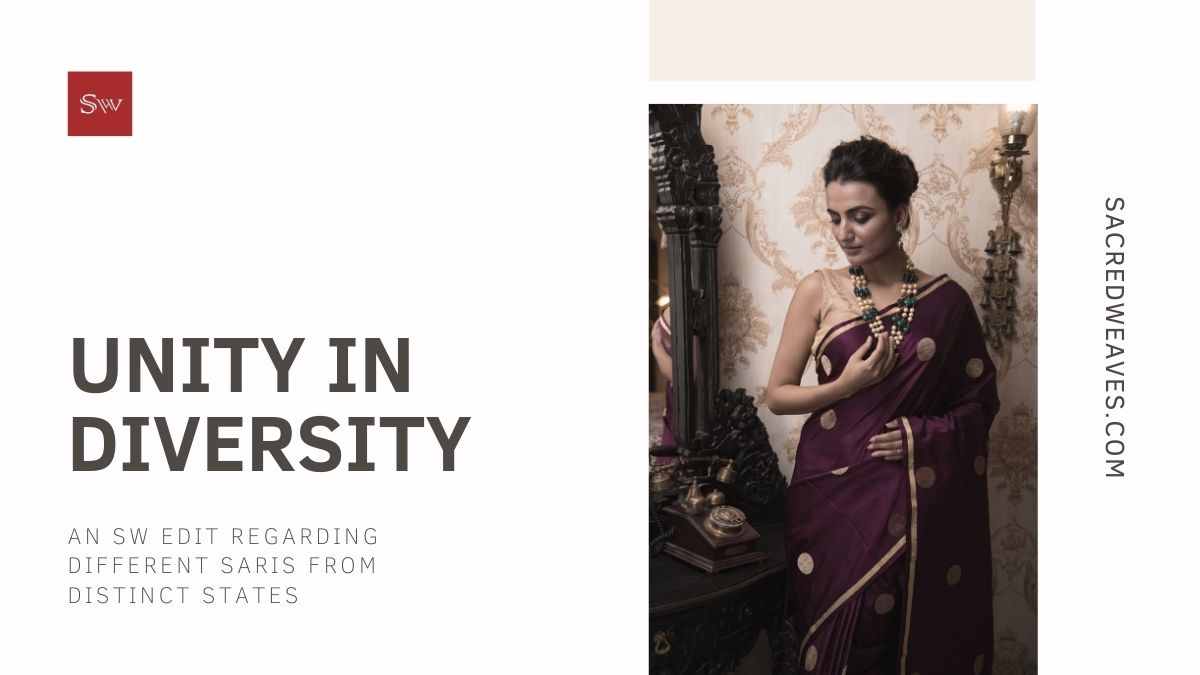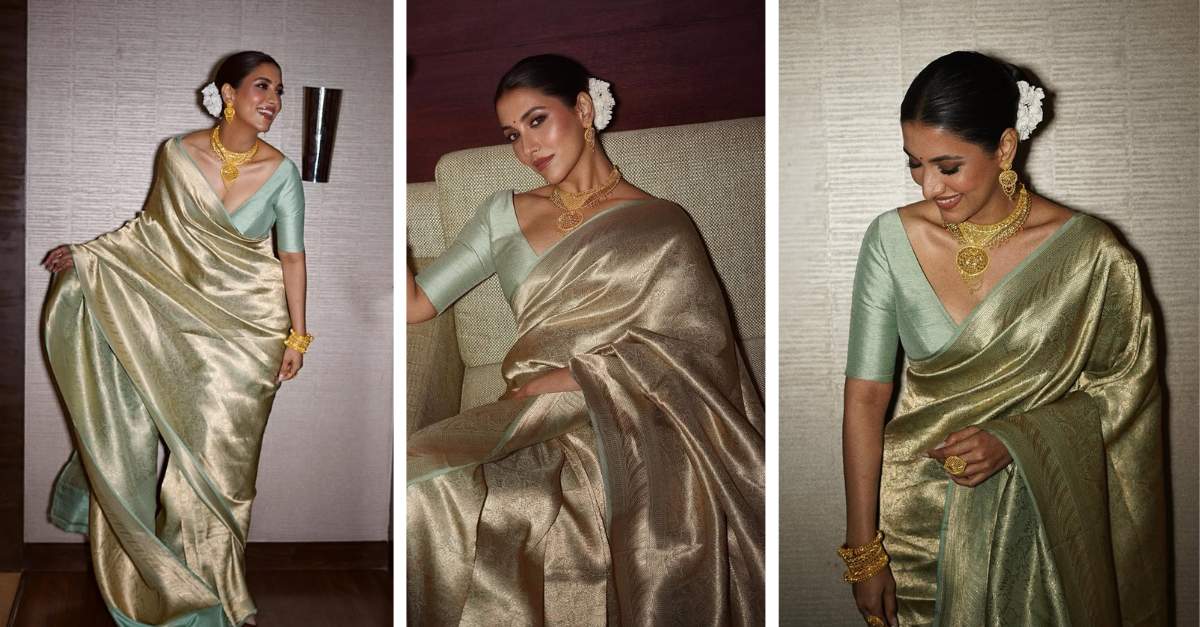
One nation, 28 states, 8 union territories and 138.07crores of people constitute the sacred land as we call it India. Being one of the widest countries spread in approx. 3.287 million km sq., the land of customs, rituals and religion is not distinct on any front despite being divided by the contour of the border. Where the god and goddess are equally praised as Allah and his devotees, where the cross is hung in all houses with the sayings of Buddha, where Thanksgiving is equally praised with the lights of Diwali, India is a place of unity, a summit of solidarity, an apostle of unanimity.
The country inhabiting 22 different languages, but a single symbolic smile is what constitutes the beauty of the nation secularised not with particularity but singularity.
The richness comes out through the cracks of holy land offering different grubs, divergent ordinance and contrast regalia.
But what comes out as the primal indistinguishable choice is the 6 yards of pure grace, and when we say so we depict the wardrobes engulfed with various colors of saree and its varied elegance. The saree is not just a fashion sense or a glad rag but a thread stitching the emotions of mother to the mother and her daughter she will wed off. India as a country with a variety of variations also offers a beautiful curve/range of sarees intrinsic from different communities.
Sacred Weaves family bring forth to you some quite common yet startling collections across the nation in the understated list:
- Banarasi Silk from the ancient city, Varanasi: The word goes commonly as Kataan from the place of origin, in a city older than mythology and its widespread culture named Varanasi. The specialty lies within its benchmarking purity, strength, durability and exquisitely versatile Silk that is produced with efforts none less than seeking summits. The procedure starts by twisting two strands of natural silk so as to forge the yarn, which when is put forth to concoct some stupendously enduring fabric. The art of entwining is of medieval ages and was introduced by the majestic mogul emperors from the sovereign lands of Persia (present-day Iran) which was and will always be a craft of exemplary artistry. The silk being the stalwart in the world of fabrics is a product extracted from silkworms which are further harvested to confer the fabric softer than divinity.
- Bandhanifrom the land of heritage, Gujrat: Natural by ingredients is a class in its own but when being woven naturally then what can outcast this duo? Bandhej originated from Sanskrit means “to bind, to tie”. Not a saree but an art form made by plucking cloth with the fingernails into numerous discrete bindings turning out into a figurative layout. Majorly practiced in areas around Gujrat, Rajasthan, Sindh & Punjab region is an ingenuity & dexterity practiced first as early as 4000 B.C back to the times of Indus Valley civilization. The Purity is too massive that evidence of this delineation can be seen in the 6th-century paintings showcasing the life of Buddha excavated on the walls of Ajanta. Colors and its kind hold significant nitty-gritty of kinds of beliefs that wearing Red Bandhej brings good luck to a newly Wed’s life.
- Taant from the land of joy, West Bengal: Cotton weaved, light-weighted, wide bordered embedded with beautiful prominent motifs and boteh makes this one of the regularly wore delicacy in the lands of Bengal. The humid conditions of Bengal make this one of the most favorable outfits for all the homely or working feminine.
- Kasavu from the God's own land, Kerala: This is one special type primarily adopted from a traditional phial of fibre, known as Dhoti or Mundu backed with a blouse and a stole going across the blouse. The successive generations are keeping this tradition breathing whereas the contemporary version is what is known as Kasavu, braced with a wide golden border twisting strands of real gold. More of which is now diversified with different colors to give it a modern blend.
- Kanjeevaram from the land of temples, Tamil Nandu: Rich in colors and woven with the unorthodox S & Z twist enhancing texture is what makes Kanjeevaram, the Queen of Sarees. Kanjeevaram is one of its kind and gives a feel of elegance, grace and vibrance just being in the wardrobe and goes like an apostle of beauty when worn.
- Paithanifrom the land of saints, Maharashtra: Named after the Paithan town in Maharashtra, Paithani has erupted as the most valued silk handwoven saree in the lower part of the country. The saree has fine work of zari in its body and holds a wide variety of Boteh in its making. From the historic times, it has been a symbol of artistry from the Artisans. SW brings you the attention towards a historic beauty in its house categorized as a sheer experience of elegance.
- Moongafrom the last of red river, Assam: An unexampled epitome of delicacy, richly finished property, and the common impression. With a mix of the best scope of strings and the best weaving method, these sarees contact each layer of silk. You will consistently get each piece deserving of its custom and money related worth. Along these lines, choose and purchase the moonga tussar silk with bright striking themes and prepare to feature the silk custom in the following event.
- Chanderi Silk from the land of Royals & Gods, Madhya Pradesh: Woven with a blend of silk, zari and cotton, Chanderi silk is one of the lightest and is often compared to that of a feather. The unique weaving technique gives gorgeous imperial gleam. Chanderi Silk is one such evergreen & timeless sarees that evoke festivity & joy. Classic motifs featured on cotton silk makes it a splendid drape.
- Chikankari from the land of nawabs, Lucknow: Priorly woven on muslin, Chikankari is a state of art magnificence handcrafted by the artisans from the soil of Lucknow. The Chikankari is a beautiful blend of both cotton works and motifs on muslin fabric priorly but is now cherishable wizardry over all the fabrics mastered by the contemporary weavers.
- Leheriya from the land of forts, Rajasthan: Leheriya was priorly Bandhani, when later it was improvised in Rajasthan with a different dying technique to give Bandhani a sense of leher (diagonal lines) turning it into Leheriya. A Bandhej and a Leheriya saree is made alike during the weaving process but the difference lies in the process of tying during the dying procedure. Leheriya is one of the most attractive yet comfortable saree to own and bless the wardrobe with. In modern times the leher is being weaved too along with some sarees getting traditional tie-dye technique.
The list doesn’t end here and it would be unwise to say that our nation offers just these varieties but a hundred more which are inconceivable to pen down in just a folio and thus gratifying the vastness of our soil, the soil of diversity, yet harmony under a single sky.







Leave a comment (all fields required)